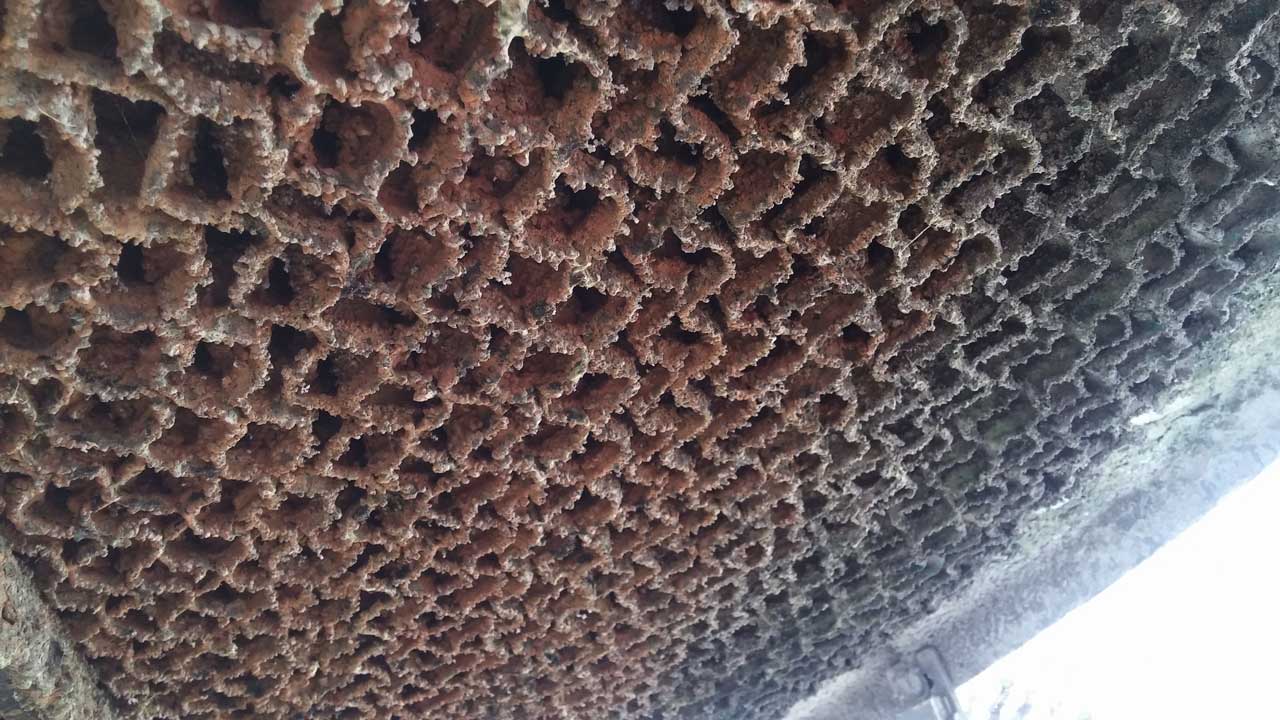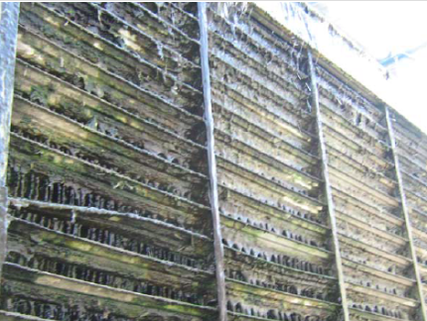Cooling towers are critical in many industrial and HVAC systems, tasked with the efficient rejection of waste heat. However, they face significant challenges, some of them are limescale formation, high blow-down requirements, and biofilm/algae build-up. Addressing these issues effectively is key to maintaining system efficiency, longevity, and environmental compliance. In this blog, we explore these challenges and conclude with a compelling case study from Central Pacific Plaza in Honolulu, Hawaii, where innovative solutions redefined cooling tower operation.
The Perils of Limescale on Heat Exchangers and Tower Surfaces

Limescale, a common yet formidable challenge in cooling tower operations, is primarily composed of calcium carbonate (CaCO3). It forms as a result of the evaporation process within the cooling towers, leaving behind minerals that crystallize on surfaces. This issue is not just a minor inconvenience but a significant operational hazard with far-reaching implications.
Impact of Limescale Accumulation:
- Reduced Heat Transfer Efficiency: Limescale acts as an insulating layer on heat exchangers and tower surfaces. This insulation effect impedes the heat transfer process, forcing the system to work harder to achieve the desired cooling effect, leading to increased energy consumption and higher operational costs.
- Accelerated Equipment Wear and Tear: The presence of limescale can accelerate the wear and tear of cooling tower components. It causes corrosion under the scale and can lead to leaks and damage to critical parts of the system, such as pumps and pipes.
- Increased Operational Costs: The inefficiencies brought about by limescale build-up translate into higher energy bills. Additionally, the costs associated with the repair or replacement of damaged equipment can be substantial.
- Decreased System Lifespan: Consistent limescale build-up can shorten the lifespan of the cooling tower and associated equipment. Regular maintenance to remove limescale can mitigate this, but it also incurs additional labor and downtime costs.
Strategies for Mitigation:
- Salt Based Treatment: Reduces the calcium and magnesium content in water, limiting limescale formation.
- pH and Chemical Management: Proper pH control and the use of scale inhibitors help prevent limescale deposits.
- Routine Maintenance: Regular cleaning and descaling extend the life and efficiency of cooling systems.
Managing Blow-Down Levels Efficiently
Blow-down in cooling towers is a crucial process for maintaining water quality and preventing the buildup of dissolved solids and impurities. However, managing blow-down levels efficiently is vital to ensure environmental sustainability, conserve water, and reduce operational costs.
Understanding Blow-Down Necessity:
- Concentration of Dissolved Solids: As water evaporates in a cooling tower, minerals and impurities in the water become more concentrated. Without proper blow-down, these concentrations can reach levels that promote scale formation, corrosion, and biological growth.
- Maintaining Water Quality: Regular blow-down helps maintain the water quality within the cooling tower, ensuring the system operates efficiently and safely.
- Water Wastage: Excessive blow-down leads to significant water wastage, which is not only costly but also environmentally unsustainable, especially in regions with water scarcity.
- Increased Operational Costs: More blow-down means more make-up water is needed, along with increased use of chemicals to treat the new water, leading to higher operational costs.
- Environmental Impact: The discharge of blow-down water can have environmental impacts, especially if the water contains high levels of chemicals and minerals.
Strategies for Efficient Blow-Down Management:
- Automated Control Systems: Installing automated control systems that measure the conductivity or total dissolved solids (TDS) in the cooling water can optimize the timing and extent of blow-downs. These systems can precisely determine when blow-down is necessary, reducing water waste.
- Increasing Cycles of Concentration: By increasing the cycles of concentration (the ratio of dissolved solids in the blow-down water compared to the make-up water), operators can reduce the frequency of blow-downs while maintaining water quality. This requires careful monitoring to avoid scaling and corrosion.
- Water Treatment Techniques: Using advanced water treatment technologies can allow for higher cycles of concentration. For example, reverse osmosis or side-stream filtration systems can remove impurities from the cooling water, thereby reducing the need for frequent blow-downs.
- Reuse of Blow-Down Water: Exploring opportunities to reuse blow-down water in other applications within the facility, such as irrigation or flushing toilets, can significantly reduce water waste.
- Optimizing Chemical Treatment: Efficient use of chemicals can help control scaling, corrosion, and biological growth at higher cycles of concentration, reducing the need for frequent blow-downs.
Preventing Biofilm and Algae Accumulation

The accumulation of biofilm and algae in cooling towers presents significant challenges to their operation and maintenance. These microbial growths not only decrease system efficiency but also pose health risks. Understanding and implementing effective strategies to prevent their accumulation is therefore crucial.
Understanding the Risks of Biofilm and Algae:
- Reduced Efficiency: Biofilm and algae can clog pipes and reduce the heat transfer efficiency of the cooling tower. This inefficiency leads to higher energy consumption and operational costs.
- Corrosion: Biofilms can induce and accelerate corrosion on metal surfaces, leading to equipment deterioration and potential system failure.
- Health Hazards: Certain types of biofilm can harbor harmful bacteria like Legionella, posing serious health risks to individuals exposed to aerosols from the cooling tower.
- Increased Maintenance Needs: Systems with significant biofilm and algae require more frequent and intensive cleaning, leading to increased downtime and maintenance costs.
Strategies for Prevention and Control:
- Regular Cleaning and Maintenance: Regular physical cleaning of the cooling tower, especially in areas prone to stagnant water, is essential in preventing biofilm and algae growth.
- Biocides: Chemical treatments with biocides are effective in controlling microbial growth. It's important to use these chemicals judiciously and in compliance with environmental regulations.
- Ultraviolet (UV) Light Treatment: UV light treatment can be a non-chemical alternative for controlling microbial growth. It works by damaging the DNA of microorganisms, rendering them unable to reproduce.
- Automated Monitoring Systems: Implementing automated systems to monitor water quality parameters like pH, temperature, and nutrient levels can help in early detection and control of biofilm and algae.
- Optimizing Water Flow: Ensuring optimal water flow and preventing areas of stagnation in the cooling tower can reduce the likelihood of biofilm and algae formation.
- Side-stream Filtration: Using side-stream filtration helps remove particles and nutrients from the water that would otherwise feed biofilm and algae growth.
- Altering Water Chemistry: Adjusting the water chemistry to make the environment less hospitable for biofilm and algae can be effective. This might include pH adjustment or altering other chemical parameters.
- Environmental Control: Reducing sunlight exposure and controlling ambient temperature around the cooling tower can help in limiting algae growth, as these are key factors in their proliferation.
Case Study: Central Pacific Plaza, Honolulu, Hawaii
As a practical application of these strategies, let's examine the Central Pacific Plaza bank building. Previously reliant on chemicals to control limescale, corrosion, and biological growth, the facility sought a more sustainable solution. They implemented a Custom 14” HydroFLOW® unit, using hydropath technology to treat water in their two 300 ton cells and one 75 ton cell cooling system.
Over a 90-Day Evaluation Period:
- Chemical Reduction: Antiscalant and anti-corrosive chemicals were discontinued, while biocide usage was cut by 85%.
- Operational Efficiency: Limescale and corrosion were controlled effectively, and bacteria levels dropped dramatically from 100,000 CFU to 1,000 CFU.
- Water Conservation: Blow-down was reduced by 50%, and conductivity levels remained stable, indicating efficient water usage and quality.
Conclusion
In conclusion, this blog post highlights the critical challenges faced in cooling tower operations: limescale formation, blow-down management, and biofilm/algae accumulation. It discusses various strategies for addressing these issues, emphasizing the importance of innovative, sustainable solutions. The case study of Central Pacific Plaza demonstrates the remarkable effectiveness of HydroFLOW® technology in overcoming these challenges. By reducing chemical dependency and enhancing operational efficiency, this case study serves as a blueprint for future advancements in cooling tower management, offering valuable insights for those seeking eco-friendly and cost-effective solutions in similar settings.


